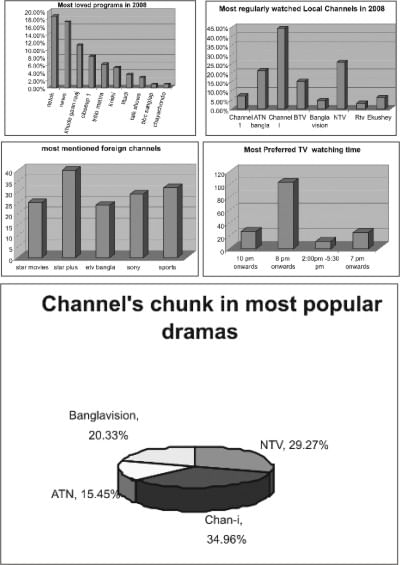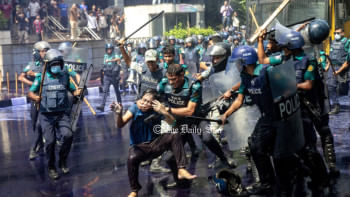What do Bangladeshis watch on TV?

IF, in 2007, you had asked television station owners in Singapore, Taiwan and India, they would talk about IPTV, Mobile TV, their increasing potential and how they were making traditional media rates cheaper. Bangladesh is still not mature enough to start talking about those. We are still trying to bring cable television to the homes of 150 million people.
Only 25% of the population had access to cell-phones, according to a survey in July last year, and 7% had access to the internet. In this article, we look at the kind of programs people appreciate on television.
The adoration of the drama persists, and the channels showing local "pop-rural culture" seem to be gaining larger market shares. If one is traveling, one can see these same natoks on DVDs, which are ubiquitous. If you are a frequent traveler, you may find you are watching the same characters in the same set-ups again and again, only the title may have changed!
Gone are the days of BTV's romances or portrayals of classical literature. The local television channels that are most likely to gain market share are those that show comical socio-political plots. Why? Apparently, the viewers love to follow the plight of new faces such as Mosharrof Karim and Chanchal Chowdhury, desperately in love and fighting against village murubbis. If the plot is sensational and has music, people will get hooked.
The most regularly watched television show in the country, in January 2009, was Khude Gaan Raaj (53% cable viewers), a reality show that seeks out the best singers among school-going children and toddlers.
Here's a summary of the very latest study done across 2000 households in rural and urban Bangladesh by a communication analysis firm, Media Arts & Technology Research.
The respondents were asked to state what programs they most liked in 2008. Nearly 19% mentioned dramas on any channel, followed by news (17%). Please note, they refrained from specifying a particular name or channel. But 11% mentioned a specific program in 2008 that they most liked, the children's musical talent show Khude Gaan Raaj, far surpassing a more established youth talent hunt platform, Closeup 1 (8%).
The political debate program, Tritiyo Mattra, received 6% of the pie, and agriculture related documentary type programs got a little over 5%. Even with its legendary status and the benefit of a terrestrial platform, Ittyadi, the fun magazine show, got only 3%.
Since dramas are so appealing, the next survey question was, which dramas did you most enjoy in 2008? Over 16% singled out Housefull (Ntv), 11% mentioned Shapnochura (Banglavision). Tolpar (Channel i) and 420 (Channel i) got over 10% each. Close contenders were Amader Nurul Huda, Ronger Manush, Lal Neel Beguni, Vober Haat, and Ghor Kutum, were next. Third tier preferences went for Gulshan Avenue, Byasto Dactar, and Aim in Life.
If we add up the most popular mentions regarding dramas, the television channels pie will look like this.
Another point of the survey was to find out who were the most popular TV personalities in 2008. The most votes were for Zahid Hassan. Surprisingly, Mosharrof Korim and Chanchal Chowdhury -- who were the leads of most popular dramas as well -- earned second position. The female faces at par with their popularity are Aupee Karim and Tisha.
In the second tier, we have new music sensations Balaam and Habib neck and neck, sharing their glory with legendary actress Shubarna Mustafa, who was visible in a talent hunt show as judge and also in a popular daily soap style production.
In the third tier are Bipasha Hayat, singer Asif, news anchor Mishu Rahman, singer Andrew Kishore and actor Asaduzzaman Noor.
Analyse this and you will see how Bangladeshi TV audiences are welcoming new talent, hence the popularity of certain channels who realise this and are designing programs according to the liking of the audience.
The mix of socio-political comedies and daily soap style drama are most preferred by audiences, and these are most seen in Channel i and NTV. The most watched musical talent shows are aired by them. Yet the most hated feature mentioned by the respondents -- too many advertisements -- is also seen in these two channels. Surely audiences don't mind the clutter, if they are given the programs they demand.
Interestingly, the most preffered watching time is from 8 pm onwards, when the most lucrative competition from foreign channels available in Bangladesh also kick in. Many respondents are also fans of Star Plus, Sony, sports channels, and Hollywood movies. With such glamorous competition, if our little tykes with microphones were successful in stealing audiences, even more so than the regular talent hunt shows, last year's deshi programming definitely gives us food for thought.

 For all latest news, follow The Daily Star's Google News channel.
For all latest news, follow The Daily Star's Google News channel. 



Comments